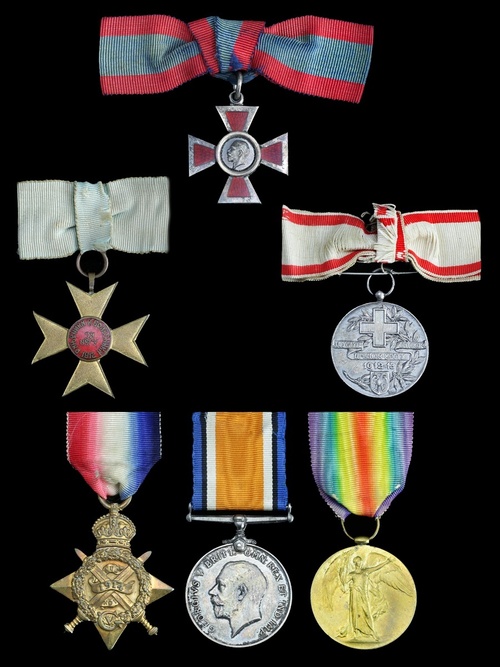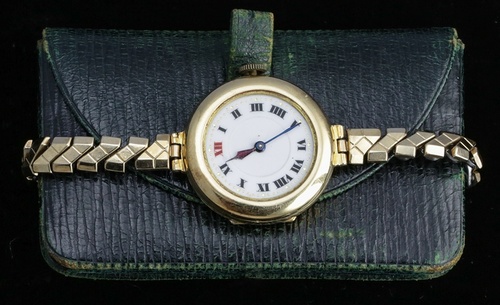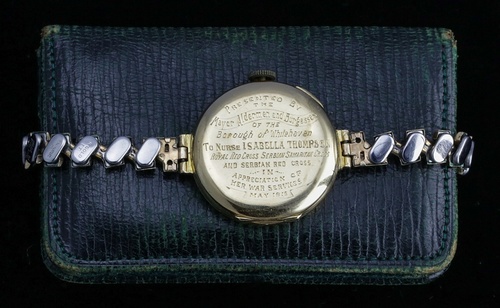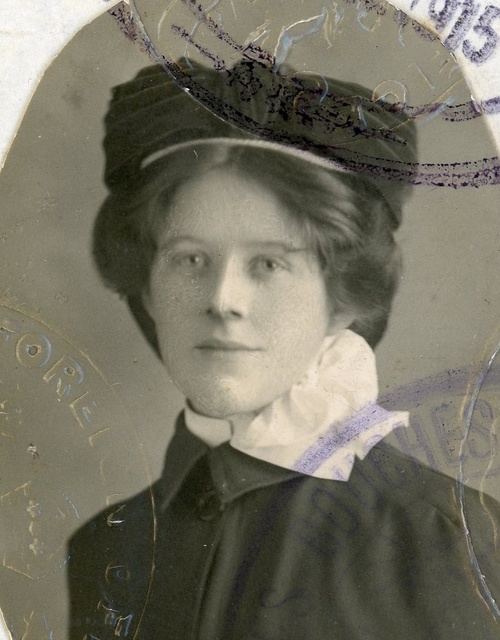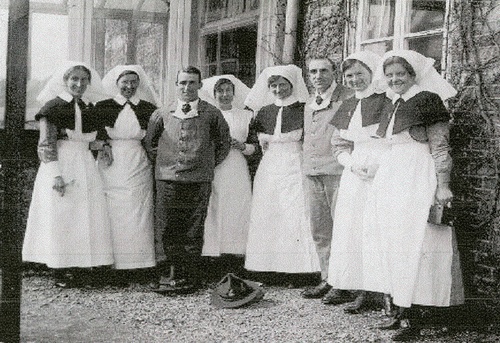Auction: 18001 - Orders, Decorations and Medals
Lot: 574
An outstanding Great War A.R.R.C. group of six awarded to Nursing Sister Isabella Thompson, Queen Alexandra's Imperial Military Nursing Service Reserve, late of the Auxiliary Hospital Unit, Antwerp in 1914 and of Mrs. St. Clair Stobart's Hospital Unit in Serbia in 1915
The Royal Red Cross (A.R.R.C.), Associate's breast badge, silver and enamel, on Lady's bow in its Garrard & Co. Ltd. case of issue; 1914 Star (Nurse J. Thompson, Aux. Hosp. Unit Antwerp); British War and Victory Medals (I. Thompson); Serbia, Cross of Mercy, bronze-gilt and enamel; Serbia, Red Cross Society Medal, silver, together with her ring (silver hallmarks for Chester, 1912), a 'lucky horseshoe' brooch and an 18ct. gold presentation watch, the latter inscribed to her in appreciation of her war services from the Mayor, Aldermen and Burghesses of Whitehaven, May 1919, generally very fine and better (6)
A.R.R.C. London Gazette 1 January 1919.
Isabella 'Belle' Thompson was born on 8 June 1889, the daughter of Councillor and Mrs. Thompson of Tangier Street, Whitehaven. Having worked as a housemaid, young Belle opted for a career in nursing and trained as a Theatre Sister at the Central London Sick Asylum 1911-14.
France and Belgium 1914-15
In August 1914, she applied to join Queen Alexandra's Imperial Military Nursing Service Reserve, prior to volunteering to serve at Mrs. St. Clair Stobart's Auxiliary Hospital at Antwerp. However, she arrived in Belgium in early November 1914, following the hospital's hasty retreat as the Germans entered Antwerp. The unit subsequently established Anglo-French Hospital No. 2 at Chateau Tourlaville, Cherbourg.
An excellent account of the unit's work at Cherbourg in the period November 1914 to March 1915 was later published by one of its doctors, Miss Mabel L. Ramsay, M.D., Ch.B.(Edin.), who lists Nurse Thompson among the staff. She refers to the Chateau as Tourbeville, rather than Tourlaville:
'Within three weeks of the return of the Hospital Unit from Antwerp, the Unit was gathered together and through Lady Guernsey an invitation was received from the French Red Cross to go to Cherbourg as large numbers of French wounded were being landed there from Calais at the rate of over one thousand a day. Hospitals were crammed and help was urgently needed. The Joint Committee of the Red Cross Society and St. John's Ambulance Association had just been formed. The Hospital Unit had gathered together £1,000 and had everything fully equipped and were able to maintain themselves for at least six months, therefore the departure of the Unit for France was officially sanctioned by Joint Committee. The Unit was passed as fit for service in France and passports, etc. issued to members of the Unit. On November 2nd Dr. Mabel L. Ramsay accompanied by Miss Monica Stanley, Lady Guernsey and Lady Rodney crossed from Southampton to Cherbourg.
Lady Guernsey had already secured a 'locale' for the proposed hospital at Chateau Tourbeville, 3 miles from Cherbourg. An inspection was necessary as to whether the building could be utilised. Water supply, sanitation, lighting, etc. The first thing to be done on arrival at Cherbourg was to interview the Chief Medical Officer Dr. Couteaud at l'Hopital Maritime and the Commander-in-Chief. These officers were very courteous and welcomed gladly the offer of help. Dr. Couteaud scrutinised carefully the medical personnel and each person's degrees and qualifications had to be explained to him. The French Authorities were a little taken aback at 'women surgeons,' but finally were satisfied that they could work. Having consented to accept the Hospital Unit as an Auxiliary French Hospital, they did all they could to help us. After the interview, Lady Guernsey and Dr. Ramsay proceeded to inspect the Chateau Tourbeville.
The Chateau, a 16th century chateau was beautifully situated but was not ideal as a hospital, but Dr. Ramsay saw that with the wonderful zeal and help of the Unit which had done so well at Antwerp, the impossible could be achieved, so she telegraphed to London 'Sanitation imperfect: Help urgent: Wanted Primus and oil stoves: Electricity: No gas: Nothing prepared: Croix Rouge poor: Come as soon as possible: Difficulties surmountable.' A visit to the quays to see the arrival of the wounded confirmed the opinion that help was urgently needed. The difficulties to be faced were: 1. Only one tap of water in the kitchen to supply 150 people. 2. All drinking water had to be fetched by hand. 3. Sanitation very primitive and earth closets had to be built. 4. The Turbine Engine for electric lighting was out of order and had to be made to work.
On November 6th the Unit arrived [with Nurse Thompson] and set to work with such a goodwill that on November 8th we announced to Dr. Couteaud that we were ready to receive wounded soldiers. He was immensely impressed and that very day we received 25 cases of the 'gravement cases' i.e. cases too ill to travel further and all suffering from fractured limbs and wounds of every description.
Dr. Couteaud inspected the Hospital so rapidly arranged, and expressed himself immensely pleased and satisfied with the arrangements and grateful to Les Dames Anglais for their help. By Christmas our full complement of beds, i.e. 80, were full and we had our hands fully occupied fighting sepsis. For nearly every case had received only one dressing after having first been wounded and hence their wounds were horribly septic. Many had been wounded 7 or 8 days. We added to our efficiency by having a tent put up in front of the Chateau in which convalescents were given their meals. A piano was secured and many concerts given to the wounded men and their friends and the staff also when patients were in bed and were able to amuse themselves. Also we fixed up a six-bedded open air treatment hut and about 20 cases were treated there in continuous open air 'such as Les Anglais like,' but which the French regarded as somewhat a cruel innovation, until they saw the results. Latterly, several phthisical cases were treated. In all 206 patients were treated at the hospital and as all required 3-4 months treatment we could not take in many new cases after the hospital beds were once full.
By the middle of February the work was getting lighter and we began to have some empty beds. Fewer wounded were arriving in Cherbourg and finally at the beginning of March it became clear that the French would not send more wounded from Calais because of the submarine menace, which had begun to be serious.
Mrs. Stobart, at the beginning of February, wished to go to Serbia, and the cry for help had reached England, and she felt she could be of greater use there than in France where the pressure of work was slackening as the French organisation began to improve. So it was arranged that half the Unit who wished to volunteer for Serbia should be allowed to go. In the middle of February half the Unit went back to England to prepare to go to Serbia … '
Nurse Thompson was among the volunteers.
Serbia 1915
The story of the redoubtable Mrs. St. Clair Stobart's relief hospital in Serbia is well-known, not least for the hardships endured by its gallant nursing staff. It is a story admirably described in Monica Krippner's The Quality of Mercy - Women at War, Serbia 1915-18.
For her own part, Thompson served at 'Stobart Hospital', Kragujevac from April to July 1915. The hospital was established just outside the town, on a large open area that was formerly the racecourse, but its medical staff - originally numbering six doctors, 18 nurses and 16 orderlies - quickly sallied further afield, manning roadside dispensaries. The response, according to The Quality of Mercy, was immediate and overwhelming:
'People poured in with dysentery, diphtheria, typhoid, scarlet fever, tuberculosis, ulcers, cancer, gangrene and terrible skin infections … Each dispensary handled an average a hundred people a day, and often the doctors and nurses, using their ox-wagon ambulances, went to humble peasant homes to attend the bedridden as best they could. This humane and imaginative medical aid to neglected village people, initiated by Mrs. Stobart, was her most valuable contribution to the Serbian nation.'
Among the colourful cast of doctors was Dr. Lilian Chesney, 'a brilliant surgeon, a considerable martinet, and a most unconventional personality', whose astonished Serb patients 'stared agape at the tall doctor as she went about her rounds followed by her current pets, two geese and a small pig, which trailed in her wake wherever she went. She fed them on chocolate and red wine!' (ibid).
Such bizarre scenes hopefully provided a pleasant diversion for Thompson and her fellow nurses, for the 'high incidence' of badly injured children who were admitted to the hospital must have been challenging in the extreme:
'Terrible injuries were commonplace, caused by their playing with dangerous war toys such as discarded unexploded hand-grenades, 'dud' shells that suddenly came alive, clips of ammunition found in the grass, in deserted trenches, or by the wayside … ' (ibid).
Such deeply upsetting cases aside, a very real danger lurked in the tented compound that constituted 'Stobart Hospital': Typhus. Prior to Thompson's departure to the U.K., one of her fellow nurses, Lorna Ferris, succumbed to that illness in early July 1915. She was afforded a full military funeral. Exactly one week later, Mrs. Mabel Dearmer, 'the beautiful author and children's dramatist who had given it all up to serve as a simple orderly', suffered a similar fate. She was buried next to Lorna Ferris, 'with full honours and all the pomp and circumstance of a funeral stage-managed by the Serbian Orthodox Church.'
Home Establishment 1915-19
Following her return from Serbia, Thompson signed a contract with the Army Medical Department in October 1915 and was formally accepted into the Q.A.I.M.N.S.R. A spate of appointments in the U.K. ensued, among them No. 2 Birmingham War Hospital, in which capacity her name was brought to the notice of the Secretary of State for War (London Gazette 3 March 1917, refers); so, too, the Empire Hospital in south-west London and, finally, the famous Pavilion Military Hospital in Brighton.
She was advanced to Nursing Sister and decorated with the Royal Red Cross (A.R.R.C.), in addition to being presented with a gold watch by the Mayor, Aldermen and Burghesses.of Whitehaven on her return home in May 1919.
Tragically, Thompson lost three of her brothers in the Great War, all of them soldiers in the Border Regiment: Wallace, who was killed in action at Gallipoli in August 1915; George, who died in France in March 1917, after being wounded on five occasions; and Frank, who was killed in action at Arras in April 1917.
'Belle' Thompson died at Whitehaven on 11 November 1978.
Sold with original War Office Buckingham Palace investiture letter, addressed to Thompson at the Brighton Pavilion Hospital, dated 21 February 1919, together with her parchment passport, with portrait photograph, and assorted stamps for movements in France and Serbia, issued on 18 August 1914; together with copies of Ruth Mansergh's Whitehaven in the Great War, which includes an entry in respect of Thompson, and Monica Krippner's The Quality of Mercy, and a file of copied research and a number of cuttings taken from The Great War Illustrated, the whole relevant to the Serbian campaign in 1915.
Subject to 20% VAT on Buyer’s Premium. For more information please view Terms and Conditions for Buyers.
Sold for
£5,500

